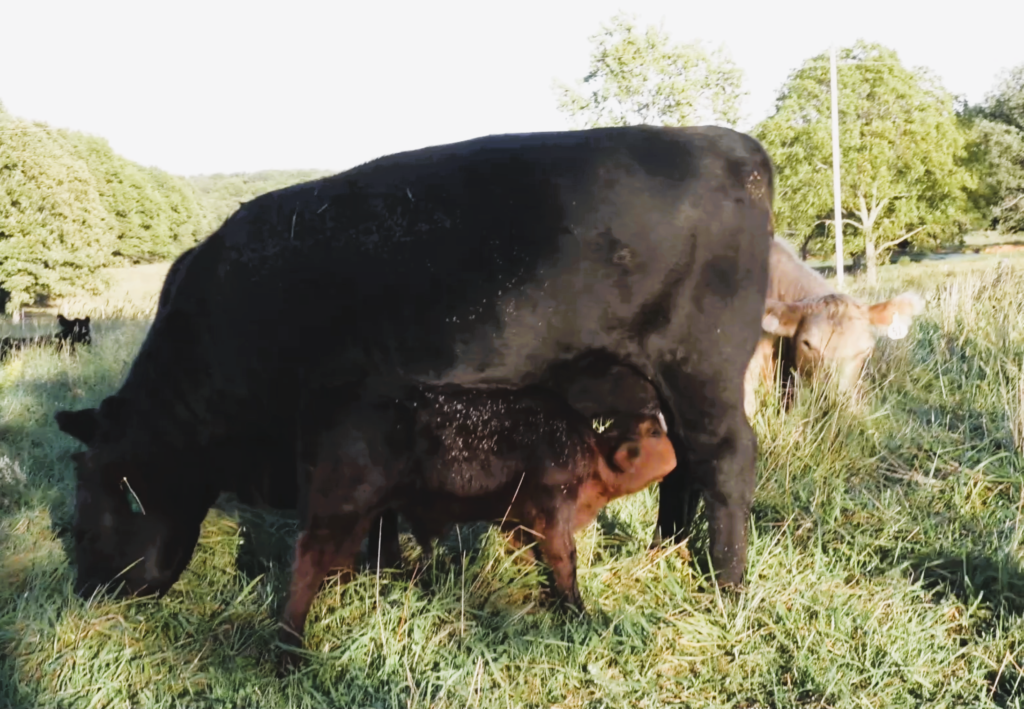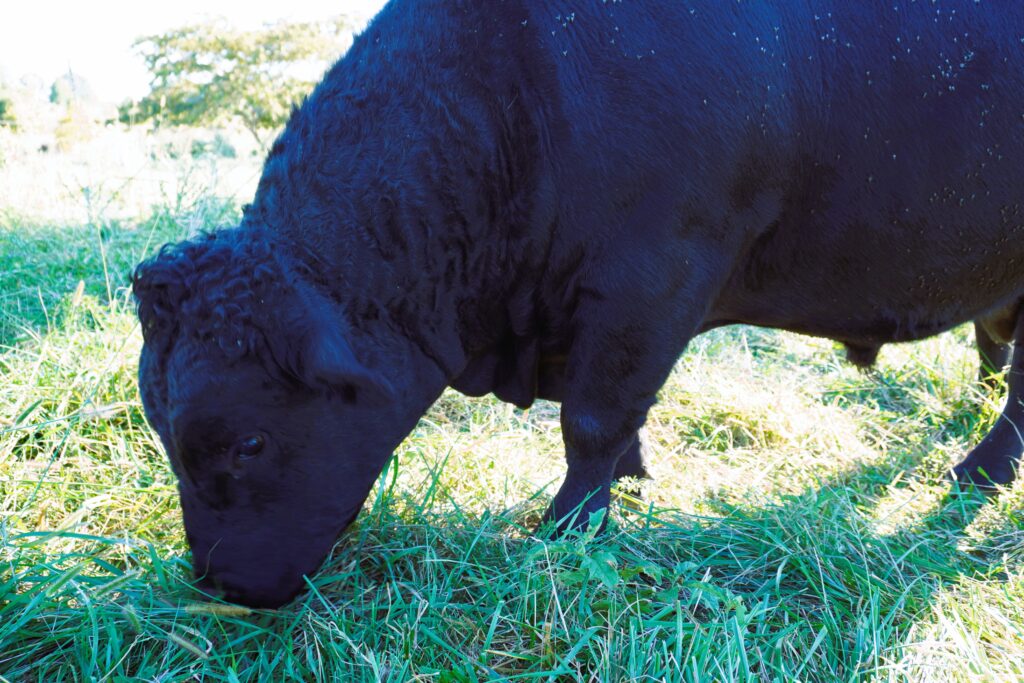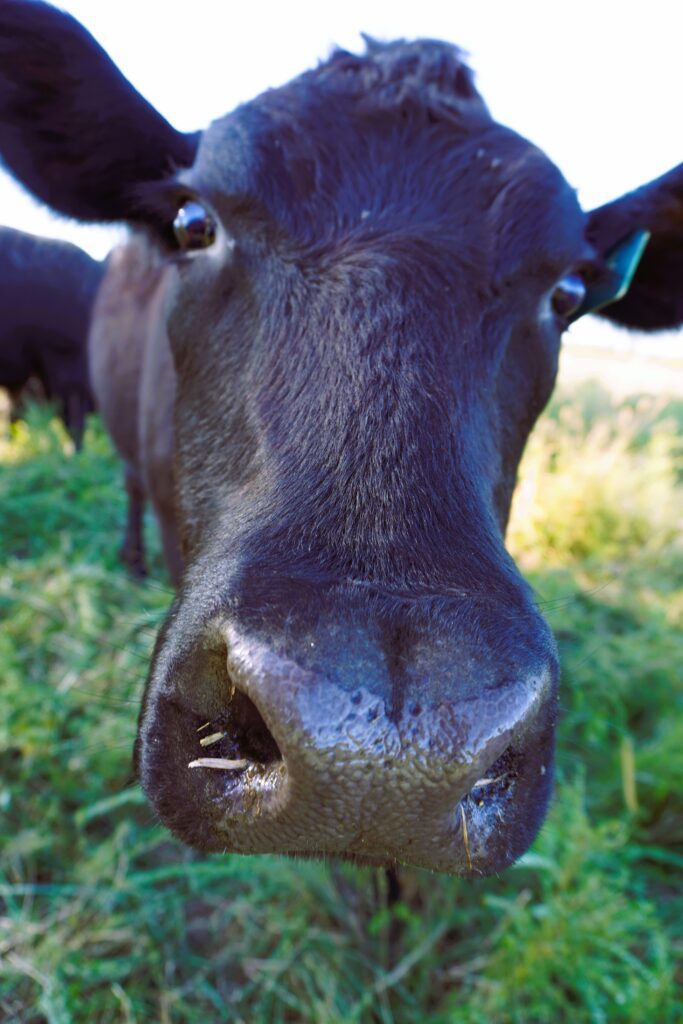Most people who know much of anything about cattle have probably heard of the Angus breed. In fact, they’re probably the most popular breed of cattle there is right now, at least in the United States. Why? Well, Angus cattle easily meet all of the characteristics that are used to determine the quality and pricing of beef.
They are also easy keepers, meaning that the cows are good mothers, they do well in most climates, they are polled (no horns), they are easy calvers, they do well when being crossed with virtually any other breed, and they are less susceptible to stress from pinkeye, sunburn, and pests. And that’s not even a full list.

Lowline Angus
My cattle are Angus, but not what most people would think of. Mine are Lowline Angus. That means that they are smaller than your average registered or commercial animal. A full grown Lowline Angus cow weighs about 900 lbs. and is about 40 inches tall at the hip. A bull like old Sampson averages about 1200 lbs. and around 45 inches tall. A conventional Angus cow weighs around 1200 lbs. with bulls tipping the scales at about 1800-1900 lbs. Conventional cows and bulls come in at around 53 and 57 inches at the hip, respectively.
Of course, Lowline cattle are a whole lot less conventional than the larger cattle. In fact, the beef market is set up for larger cattle from the sale barn to the feed lots to the packing facilities. Handling equipment is geared toward larger cattle as well. So, why would I choose Lowline cattle for my farm? Well, from time to time I can be an unconventional kind of guy. Of course, that’s probably not the answer you’re looking for.
The real reason I like these cows is because the potential for profit is much higher than it is with traditional cows. And I’m not just talking about selling breeding stock to people that are looking to get into the next fad or trend. I’m talking about real beef production.
Click here to watch us bring these cows home!

Now, you might be wondering how it’s possible for these cows to present a greater opportunity for profit when the current market system is not favorable to them, based on size alone. If I were to take a load of these cattle to the local sale barn, I’d probably lose money because the buyers aren’t interested in these animals. They don’t fit the current market system.
So, what is it about these animals that makes me say that they offer the greatest potential for profit on my farm? Well, believe it or not, it’s their size and their ability to finish into a well marbled product on minimal or no grain.
Small Cows=More Money
Let me tell you what I mean. Being smaller brings a few different benefits that are often overlooked by the conventional market. The first being that smaller cattle require less inputs, or feed. These cows eat about a third less than a more conventional sized animal. Now you may be saying, of course they do, because they’re only two thirds the size of that conventional animal. While true, that’s not exactly what it might seem on the surface because a Lowline that is butcher weight will produce a retail carcass yield somewhere around 75%. A conventional angus will produce about 68%. So, what does that mean? Please stick with me because we’re about to wade off into some weeds here, but this information is very important. Based on averages, a 1200-pound conventional steer will produce a 750-pound carcass weight and 510 pounds of retail cuts while a 900-pound Lowline steer will produce a 560-pound carcass weight and 420 pounds of retail cuts. That’s only 18% less beef on about one third less feed.
Or another way to look at it is this, 3 Lowline steers will produce 1260 pounds of retail cuts on the same acreage that it takes 2 conventional steers to produce 1020 pounds of retail cuts. That’s 240 pounds more beef on the same acreage. Now you might be thinking, “Andrew, that’s all well and good bud didn’t you just say that you’ll get penalized at the sale barn if you bring in Lowline cattle?” Yes, I did say that.
So, you have to be committed to marketing your own product. If you don’t like people, this may not be for you. However, if you don’t mind doing the leg work it takes to sell your own beef, either as wholes, halves, or even retail cuts, Lowline cattle might just be for you. For those who sell beef in halves and wholes, that lighter weight is a little bit more palatable to those who are writing the checks.
If the idea of Lowline cattle excite you, here are a couple other reasons to consider them for your farm.
Benefits of Lowline Angus
These cattle are naturally quite docile. Now that’s not a trait that is exclusive to Lowline Angus, but it is a very prominent trait within the breed. When I was growing up my dad tried out several different breeds throughout the years. Some of those were more prone to orneriness than others. In fact, my brothers and I joke that dad’s philosophy toward his cattle was, “that old girl might kill one of us some day, but she sure raises a good calf.” I did not inherit that philosophy from my dad. If she causes trouble, I don’t care what kind of calf she raises, I don’t want her on the place.
Docile cattle are much easier to work and much easier on fences and equipment. I don’t have to worry too much about something spooking them, which is good considering the airplanes and helicopters that buzz around here from time to time. Also, my kids can come out here and not worry too much about getting chased or knocked down.
Another positive trait is that these cattle are very well suited to an intensive grazing operation, which is what I do here. Part of that goes back to what I was just saying about them being so easy to handle. They’re generally quite content wherever I put them. They are quick to learn how I move them through the pastures, and I don’t have to chase them around to get them to go from one place to the next.
The last thing I’m going to mention is their shorter gestation period in relation to other more conventional cattle. A Lowline Angus has a gestation length of 271 days, as much as 2 weeks shorter than some other large breeds. That means that those calves hit the ground and start growing just a little bit faster than their traditional counterparts.

There’s a good bit of information out there about Lowline Angus, or American Aberdeen Cattle, if you’re interested in checking them out. I’d encourage you to do a little research and see what they might be able to do for your farm.
